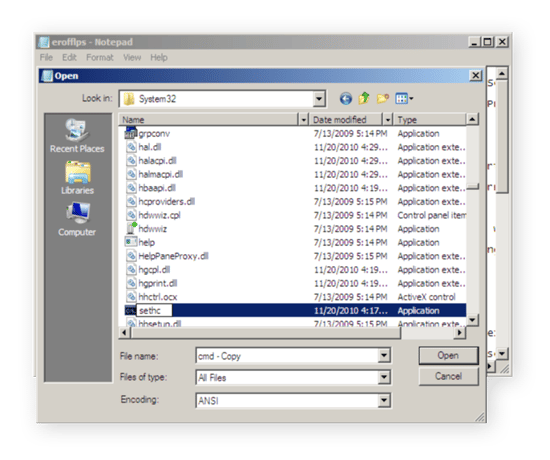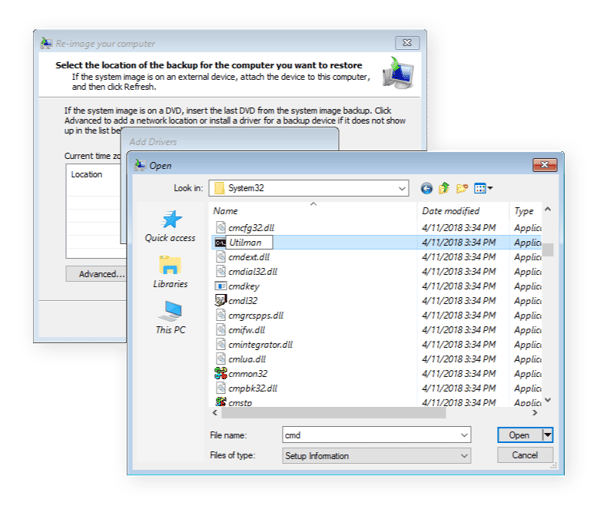Key takeaways
Tips to recover a forgotten Windows password:
-
If you're using Windows 11 or 10, use your Microsoft account to reset your password with multi-factor authentication, or use a reset disk.
-
Use a previously created USB recovery disk if using Windows 8 or 7.
-
For local accounts, follow the Windows Automatic Repair steps.
-
Try using Command Prompt and system file modifications to reset your password.
“Login and password do not match.” Oh no! If your day starts with a message like this, you’re in for a bad time. Maybe you forgot your password. Perhaps you have recently changed your Windows password and can’t remember the new one. Or you pulled an old PC out of storage and cannot recall its login details. It happens to the best of us!
How do I find my Windows password?
If you’re using a Microsoft account to log in, you can recover or reset your Windows password using multi-factor authentication. If you’ve forgotten your computer password or can’t remember your Windows password for a local account, use the Windows Automatic Repair troubleshooting steps outlined below.
The following steps walk you through the process for (hopefully) successful password recovery, going from the easiest to the hardest things to try.
If you use Windows 7, you may be out of luck, unless you previously created a password recovery disk — which we address later in this piece.
Windows 10 and 11 users are in a good spot. The new operating system practically forces you to sign up for a Microsoft account during the installation process. If you’ve got either a Microsoft account or a reset disk, it’s very easy to recover a Windows password, with a few options at your disposal.
Before we begin, remember to always create strong, unique passwords for your accounts — you can use a random password generator to help.
How to reset your password on Windows 10 or 11
The Microsoft Windows password reset process via Microsoft login is straightforward:
-
The Microsoft computer password reset process requires an internet connection, so make sure your PC is online
-
On the Windows 10 or 11 login screen, click I forgot my password.

-
On the next screen, type in your Microsoft account email address and press Enter.

-
Next, Microsoft aims to verify that it’s really you. You can instruct Microsoft to send a code to you by email or SMS.

-
Once you receive that code, enter it into the Windows login screen. You’ll be taken through the process of entering a new (and more memorable!) password.
Windows 7 or 8: Use your Windows Password reset disk or USB drive
If you were cautious enough to create a USB recovery disk for your Windows 7 or 8 system, nice work. You’ve made Windows password recovery very easy for yourself.
-
On the login screen, click on Reset passwords.
-
Plug in your USB key (or floppy disk). Click Next.
-
Type in your new password and a password hint. Click on Next.
-
Done!
You can now log into your computer again using the password you created.
Windows 7: Recover your password (the hard way)
If you don’t have a disk or a Microsoft account to help you reset your password, you need to reset your password the hard way. Here’s how it works:
-
Turn on your computer. Wait until you see the Windows logo, then unplug the power cord or hold down the power button to force the PC to turn off. When you turn it on again, you should be greeted by this screen:
 Select Launch Startup Repair (recommended).
Select Launch Startup Repair (recommended).
-
Startup Repair now attempts to fix your problems. It won’t succeed, but it needs to try:

After a few minutes, the Windows 7 repair process fails. Windows 7 asks you if you want to send information to Microsoft. Ignore that query. Instead, click on the Hide problem details button right below it.
-
Scroll down to the very end of the text box. Click on the link X:\Windows\System32\en-US\erofflps.txt.

-
You are now in Notepad, which gives you access to your hard disk. YES! This is how the magic works: By opening Notepad and following the subsequent steps, you can work within your computer’s file system.
-
Next, click on File and then select Open. Now you need to access the C:\ drive, which probably is named Local Disk (C:\) or Windows 7 (C:\), for example.

-
See the Files of type option at the bottom? Select All files here. Then navigate to Windows, System32, and scroll down the huge list of files until you find the sethc file.

Right-click that file and select Rename. Rename the file to anything you want, such as sethcpassword.

-
Next, look for a file called cmd. Scroll back up until you find it, still in System32 directory. Right-click on cmd and select Copy. Then, click in the empty space within the window and select paste, so you get a copy of that file.

-
The result is that you end up with a file called cmd - copy. Now, here comes the hacky part: Rename that file to sethc — the exact same name of the file you renamed above!

-
Close all windows. When you reach the following Windows 7 screen again, click on Finish.

-
Restart your computer. This brings you back to the Windows 7 login screen. What you’ve done is replace the Sticky Keys accessibility option with the command line option. To access that, press the SHIFT key on your keyboard five times.
-
You’ll hear a weird beeping noise and should see this:

-
Type in the following command:
Net user
Press Enter. This gives you a list of usernames that are available, including your own. Find the one you want to log into; in our case it’s called “IEuser.”

Next, type in the following command:
Net user YOURNAME *
So for our example, we type in
Net user IEuser *
The system asks you to confirm a new password. Press ENTER key twice to use an empty password and confirm that:
 Done! Close this window. Then log in with an empty password by just clicking on the arrow button.
Done! Close this window. Then log in with an empty password by just clicking on the arrow button.
Windows 8: Recover your password (the hard way)
If you lost your Windows 8 password and don’t have a recovery disk, here’s how to reset a Windows password in Windows 8 or 8.1:
-
Reboot your PC in Advanced Startup Options (ASO) mode by holding down the Shift key and clicking Restart via the start-screen power icon.
-
When the ASO menu appears, click Troubleshoot > Advanced options > Command Prompt.
-
Type in the following command:
copy c:\windows\system32\utilman.exe
c:\
Then hit Enter. You should receive a 1 file(s) copied confirmation.
-
Then type this command:
copy c:\windows\system32\cmd.exe
c:\windows\system32\utilman.exe
Hit Enter and answer with Y or Yes to confirm the overwrite of the utilman.exe file.
-
Exit Command Prompt back to the ASO menu and select Turn off your PC.
-
Now power your machine back on. Once it’s rebooted, click the Ease of Access icon in the bottom-left corner of the Windows 8 login screen. This should open Command Prompt.
-
Type in net user followed by your username and the new password you’d like to start using. If your username has a space in it, you need to enclose it with double quotation marks. For example, someone with the username Jane Doe changing their password to B4ttle4xe89 would type:
net user “Jane Doe” B4ttle4xe89
Then hit Enter — you should receive the message The command completed successfully.
-
Exit Command Prompt to return to the Windows 8 login screen and log in using your new password.
-
Finally, repeat steps 1 and 2, then execute the following command in Command Prompt:
copy c:\utilman.exe
C:\windows\system32\utilman.exe
Confirm the overwrite by answering Yes, then restart your computer.
Windows 10 & 11: Recover your password (the hard way)
There’s not much that’s as frustrating as trying to log into a Windows computer when you don’t remember the password. If you use Windows 10 or 11, but you don’t have a recovery disk or a Microsoft account to help you reset your password, then here’s how to reset it using Windows Automatic Repair:
-
Turn on your computer and wait until you see the Windows logo. Then, unplug the power cord or hold down the power button to force the hardware to turn off. Turn it on again, and you should be greeted by this screen:

-
Choose Advanced options. Click on Troubleshoot, Advanced options, and System Image Recovery. That brings you to a screen that looks like this:

-
Click Cancel to clear the dialog box, then click on Next.
-
On the next screen, select Advanced and then Install a driver. Confirm with OK.
This brings up an Explorer window, which allows you to perform the password reset magic.
-
On the left side of the screen, click This PC.
-
Open up the C:\ drive. Depending on how the computer is configured, it might be named Local Disk (C:\), Windows 10 (C:\), or Windows 11 (C:/).

-
Navigate to Windows, System32, and scroll down the huge list of files until you find the file utilman. Right-click on that file, select Rename, and rename it to whatever you like, such as Utilmanpassword. Remember that name!

-
Scroll all the way up and find the cmd file. Make a copy of that file by right-clicking on it, selecting Copy, right-clicking on a free area in the file listing, and selecting paste. (In other words, you’re duplicating the cmd file.) Rename the original cmd file to utilman (yes, the same file name as the one you just renamed).
It should look like this now:

In order to see the changes, you might need to right-click on a free white area of this window and select Refresh.
That’s it for now. Close all windows and select Continue (Exit and continue to Windows 10 or 11). After a few seconds you’ll see the Windows login screen.
What you just did is replace the Ease of Access button (“Accessibility” in Windows 11) with the command line, which allows you to reset your password.
Click on that. You now see a command line prompt like this one:

-
Type in the following command:
Net user
Press Enter. This shows a list of usernames that are available, including your own. Find the one you want to log into; in our case it’s called IEuser.
Next, type in the following command:
Net user YOURNAME *
Or to use our example:
Net user IEuser *
-
Windows 10 or 11 now asks you to confirm a new password. Click on ENTER twice to use an empty password.

Done! Close this window and then log in with an empty password by hitting the arrow button.
How to avoid forgetting your Windows password
Don’t want the adrenaline rushing through your veins as Windows login tells you “Incorrect password” over and over? Wracking your brain to remember your Windows password?
Instead, spend a few minutes to prepare yourself for an eventual bout of password amnesia. Tip: “Write it down on a sticky note and put that on your monitor” is horrible advice.
Here’s how to prevent yourself from forgetting or losing a Windows account password.
Create a Windows password reset disk or USB drive on Windows 7
If you opted out of a Windows 10 Microsoft account, or if you’re running Windows 7, you can create a password recovery disk. Here’s a way to create a disk:
-
Plug a USB key into your PC or laptop. You can also use a floppy disk if your PC is still surfing the retro waves.
-
Click on the Start button and type in reset.
-
Click on the Create a password reset disk item.
-
Choose Next on the first screen. Select your “disk” (which realistically is a USB drive).
-
Type in your current password and choose Next again. After a few seconds, your disk is created. Store it somewhere safe, away from cats who think that USB drives are great kitty toys.
Sign into a Microsoft account on Windows 10
Windows 10 begs you to sign into a Microsoft account, and for good reason. Aside from enabling you to download apps from its store and synchronize settings from one PC to another, a Microsoft account also offers you an easy way to reset your password, as you saw above.
To set it up (or confirm you’ve got one), here’s what to do:
-
Click on the Start menu and then on the little cog icon to open the Settings app.

-
Click on Account. If you see an email address below your user name and account photo, then you already have a Microsoft account and you’re done.
-
If it looks like this, then you’re signed into a local account. You should sign up for a Microsoft account, which would enable you to reset your password in case you forget or lose it:

-
To do that, click on Sign in with a Microsoft account. You can register for an account by clicking on Create one! It’s a straightforward registration process that asks you to either create a new Microsoft (@outlook.com) address or to use an existing email ID.
-
Set up a password (which you will of course write down, promise?) and type in your first and last name. Last but not least, you can now sign into your new account using the email and password you just specified. This will be your Windows login going forward. While not the most secure method, you can also set up a PIN in Windows 10 at this point to make logging in easier.
Going forward you can reset your password using the way we described above.
Use a password manager
Password managers can safely store all your passwords, and many will also generate secure passwords for you. Choose a password manager with multi-device sync capabilities, get it set up on your computer and your smartphone, then use it to store your Windows password. This way, if you’re locked out of your computer, all you need to do is check your password manager on your phone.
What if everything fails? Reset your PC as a last resort
If none of the above methods work, then the last remaining option is to wipe your entire disk and reinstall Windows. Windows 10 and 11 make this easy by offering a reset option. To do that, click on the Power button on your login screen, select Restart, and hold down the Shift key. Go to Troubleshoot Reset this PC, and select Remove everything!
Windows 7 users can boot from their DVD or Setup USB disk and wipe the drive. However, this should be the absolute last resort. We’re quite certain that at least one of the methods documented above should work for you.




 Select Launch Startup Repair (recommended).
Select Launch Startup Repair (recommended).








 Done! Close this window. Then log in with an empty password by just clicking on the arrow button.
Done! Close this window. Then log in with an empty password by just clicking on the arrow button.














/Academy-The-top-password-cracking-techniques-used-by-hackers-Thumb.jpg)
